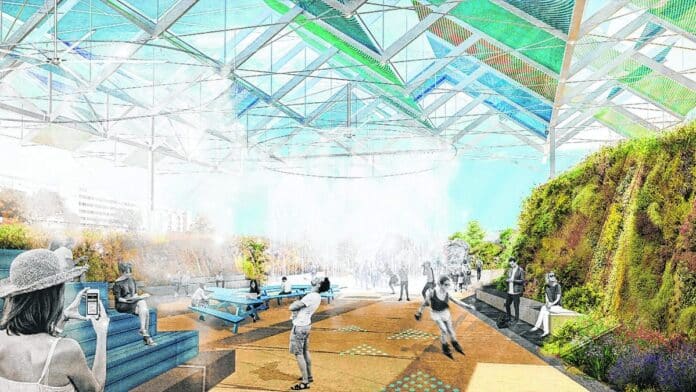
It seems only fitting that the Exhibit Columbus symposium, which has highlighted some of the finest architects worldwide, ultimately would allow one of the more creative design teammates a day in the sun: Mother Nature.
That more natural focus was a part of the second Columbus Conversation Thursday on “Resiliency and Climate Adaptation” in the symposium’s series “New Middles: From Main Street to Megalopolis — What is the Future of the Middle City.” The presentation was livestreamed on the organization’s Facebook page and its YouTube.com channel. And the taped event will remain there for some time.
Exhibit Columbus is an exploration of architecture, art, design, and community that highlights the city’s Modernist design legacy.
Exhibit Columbus 2021 Miller Prize recipients Belinda Tato and Jose Luis Vallejo of the design firm Ecosistema Urbano, based in Hollywood, Florida, and Madrid, Spain, spoke about several of their projects, done all over the globe, so closely tied in with nature and the surrounding environment.
[sc:text-divider text-divider-title=”Story continues below gallery” ]
“I’ve loved their work for many years,” said event moderator Janice Shimizu, Exhibit Columbus’ associate curator. She praised their designs for “remembering the importance of play, and for their beautiful sites and structures.”
One of the duo’s most-publicized efforts, called Eco-Boulevard in Madrid, is an urban recycling operation that naturally cools surrounding air by 10 degrees and circulates it in an area marked by a concrete streetscape. The work includes three huge “air trees” — large ecological, community pavilions ideal for social activities, playgrounds, and such. It creates relief from seasonal heat, and has created innovation mixing an agricultural and urban balance.
Plus, in photos, people are seen sitting underneath the air trees watching events — a significant development since the area previously was considered mostly unused. In other shots, cooling water sprays out the bottom of the air trees.
“We can embed an ecological approach into everything we do,” Tato said, adding that the two often focus on “climatic comfort to create better conditions for people to use public spaces.”
As a follow-up to the Madrid project, the pair created a similar air tree outdoor pavilion in Shanghai, China. One of their specialties has been in transforming little-used public spaces to popular destinations for play and a variety of community activities.
The pair is using ecological procedures in other ways to marry their designs with nature. One project, Ecopolis Plaza in Rivas Vaciamadrid, Spain, uses wastewater from an energy-efficient kindergarten to irrigate the nearby property into a lush, public space in what is normally a very dry area.
Plus, the duo created climate-controlled, outdoor classroom and lecture areas for Malaga University in Malaga, Spain, along a three-kilometer boulevard and an energy-producing children’s carousel in Dordrecht, Netherlands.
“It’s about creating a playfulness, and how we can understand that ecological sustainability can even be playful,” Tato said.
That playfulness has marked other efforts, including once turning a parking lot into a colorful, painted-design, public gathering space.
“We ask things like ‘How can we learn to engage different stakeholders?” she asked.
Amid Thursday’s presentation, a Columbus foursome — Heather Pope, Columbus’ director of redevelopment, landscape architects Randy Royer and Rachel Kavathe, and architect Jason Larrison of Core Planning Strategies — reviewed the city’s proposed and much-publicized $8.6 million Riverfront Project and highlighted the idea of merging design with nature to benefit both the landscape and people.
The project includes a public plaza area on the banks of the East Fork of White River, a recreational kayak run and another link to the People Trail.
Kavathe also highlighted the success and future possibilities of local pollinator parks, seen as a win-win for attractive public spaces for families and also for enhancement of natural surroundings.
[sc:pullout-title pullout-title=”Next for the symposium” ][sc:pullout-text-begin]
- 2 p.m. Oct. 13 livestream on the Dezeen Facebook page — New Middles: Arts and Community is a roundtable conversation between architect and urban designer Paola Aguirre, artist-writer-researcher Matthew Fluharty and artist and design strategist De Nichols. These experts will explore how arts spaces and cultural organizations are shaping the future of the middle—rural, urban, and points in-between.
- Noon Oct. 15 livestream on the Exhibit Columbus Facebook page — Will examine how might community-led cultural initiatives might bring people together today and meaningfully improve tomorrow’s civic life. Featuring Miller Prize recipients Ann Lui and Craig Reschke of Future Firm and Sam Jacob of Sam Jacob Studio in discussion with community members Jadon Darnell, Austin Lewis, Jessica Schnepp, and Kate Thomas in a conversation highlighting the ways that grassroots creative networks, Friends of the Crump Theater and NOMAD, are at the front lines of preserving cultural arts spaces, and creating platforms that amplify voices and foster creativity as community assets.
Information: exhibitcolumbus.org
[sc:pullout-text-end]




